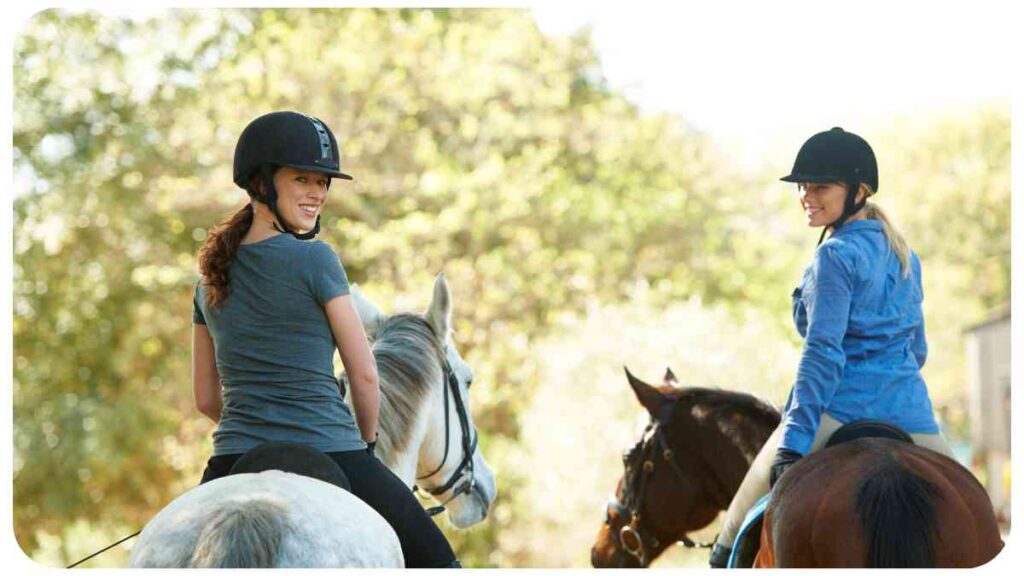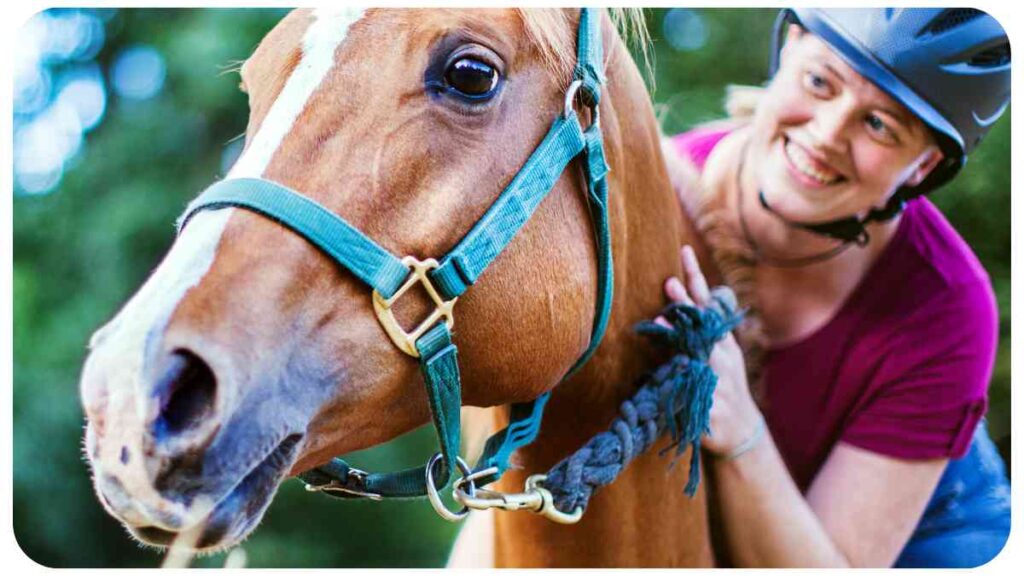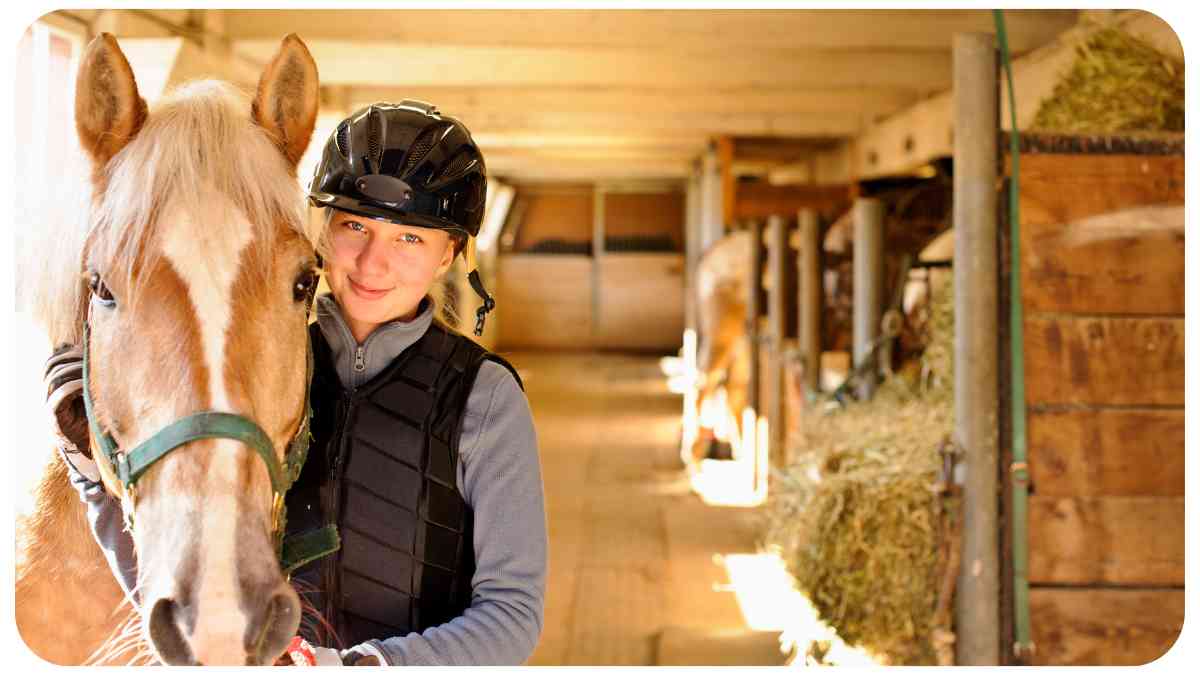Welcome to our comprehensive guide on choosing and fitting horse riding helmets. As an experienced rider, I understand the importance of safety and the role a well-fitted helmet plays in preventing head injuries. In this article, we will cover everything you need to know about selecting the right helmet and ensuring a proper fit. Let’s dive in!
| Takeaway |
| Choosing and fitting the right horse riding helmet is crucial for protecting your head and preventing serious injuries. |
| Properly measuring your head size ensures you select a helmet that fits correctly. |
| Different helmet styles cater to various riding disciplines, so choose one that suits your needs. |
| Look for helmets that meet safety standards and certifications like ASTM, SEI, PAS, or VG1 to ensure quality and protection. |
| A snug and comfortable fit is essential for a helmet, with proper weight distribution and a securely adjusted chin strap. |
| Consider helmet features such as ventilation, padding, visor, harness system, and retention system to enhance safety and comfort. |
| Regularly clean and maintain your helmet, and replace it when necessary to ensure its effectiveness. |
| Additional resources provide valuable information on measuring, selecting, and fitting horse riding helmets. |
| Frequently asked questions address common concerns when it comes to helmet replacement, fitting, safety standards, and maintenance. |
| Prioritize your safety by choosing and fitting the right horse riding helmet for your riding adventures. |
2. Why Choosing the Right Horse Riding Helmet is Important

Your head is the most vulnerable part of your body while riding, and wearing a helmet is vital to protect against the risk of serious head injuries. A properly fitted helmet can significantly reduce the impact of a fall or a blow to the head, potentially saving your life.
“When it comes to protective headgear, selecting the right one is crucial.” Find out more about the top horseback riding helmets and ensure your safety in the saddle.
3. How to Measure Your Head Size
Before purchasing a helmet, it’s crucial to determine your head size to ensure a proper fit. Use a flexible tape measure and wrap it around your head, just above your eyebrows and ears. Take note of the measurement and refer to the helmet manufacturer’s size chart to find your correct size.
4. Selecting the Right Helmet Style
There are different helmet styles available that cater to various disciplines and preferences. Let’s explore some popular options:
English Riding Helmets
These helmets are commonly used in English riding disciplines such as dressage, jumping, and eventing. They are sleek and traditionally styled, offering a secure fit and a refined appearance.
Western Riding Helmets
Western riding helmets feature a distinctive look and are designed for riders who prefer a Western-style riding experience. They offer protection while maintaining the classic cowboy aesthetic.
Endurance Riding Helmets
Endurance helmets prioritize comfort and protection during long-duration rides. They usually have additional ventilation and lightweight construction to enhance breathability.
5. Helmet Safety Standards and Certifications
When selecting a helmet, it’s important to look for safety standards and certifications that ensure quality and protection. Here are some key standards to be aware of:
“Proper riding techniques play a significant role in ensuring a safe equestrian experience.” Explore the importance of riding techniques for safety and enhance your horseback riding skills.
ASTM (American Society for Testing and Materials)
Helmets that meet ASTM standards have undergone rigorous testing to ensure their ability to protect against impact and absorb shocks related to horse riding accidents.
SEI (Safety Equipment Institute)
The SEI certification indicates that the helmet has successfully met the standards set by ASTM and is regularly tested to maintain compliance.
PAS (British Standard for Equestrian Helmets)
PAS is a safety standard specific to the United Kingdom. Helmets marked with the PAS 015:2011 certification offer protection that meets or exceeds the British safety requirements.
VG1 (European Helmet Safety Standard)
VG1 is the European standard that ensures the safety and performance of horse riding helmets. Look for helmets labeled with the VG1 certification for peace of mind.
6. Helmet Fit: Ensuring Proper Protection

Having a helmet that fits correctly is essential for optimal protection. Here are some key factors to consider when fitting your horse riding helmet:
Snug but Comfortable Fit
Your helmet should fit snugly on your head without causing discomfort or pressure points. It should not wobble or slide around when properly fastened. Remember, a helmet that is too loose may not provide adequate protection in the event of a fall.
Checking for Proper Weight Distribution
Ensure that the weight of the helmet is evenly distributed across your head. Adjust the harness system and padding as necessary to achieve a balanced and secure fit.
“Safety should never be compromised when it comes to equestrian activities.” Discover the top 15 pieces of safety equipment every rider should have for a secure and enjoyable ride.
Ensuring Proper Chin Strap Adjustment
The chin strap plays a crucial role in keeping the helmet securely in place during a riding session. It should be adjusted to comfortably fit under your chin and fastened securely. Avoid making it too tight or too loose, as both can compromise the helmet’s effectiveness.
7. Helmet Features to Look For
Besides proper fit, there are several features to consider when selecting a horse riding helmet. These features can enhance comfort, safety, and overall riding experience:
Ventilation
Good ventilation is important to keep you cool and comfortable during long rides. Look for helmets with well-placed vents that allow for sufficient airflow.
Padding
Properly padded helmets offer additional comfort and help absorb impact in the event of a fall. The padding should be soft, durable, and removable for easy cleaning.
Visor
A visor can provide protection against the sun, rain, or branches while riding. Consider your riding environment and personal preferences when choosing a helmet with or without a visor.
Harness System
A high-quality harness system ensures a secure and adjustable fit. Look for helmets with straps that are easy to adjust and fasten securely.
Retention System
Some helmets come with a retention system that allows for additional adjustment and customization. This system ensures the helmet stays in place during intense movements or sudden jolts.
“Avoiding accidents is essential for both the rider and the horse.” Learn the do’s and don’ts of horseback riding to maintain a safe and harmonious partnership with your equine companion.
8. Helmet Maintenance and Replacement
Proper maintenance and regular inspection of your horse riding helmet are crucial for ensuring its longevity and effectiveness. Here are some guidelines to follow:
Cleaning and Care
Regularly clean your helmet to remove dirt, sweat, and debris. Use a mild soap or helmet-specific cleaner and a soft cloth or sponge. Avoid using harsh chemicals or abrasive materials that could damage the helmet’s exterior or interior padding.
“Protecting your head is paramount in horseback riding.” Discover the importance of wearing a helmet for your safety and prevent head injuries while enjoying the equestrian sport.
Helmet Lifespan and Replacement Guidelines
Horse riding helmets have a lifespan of approximately 3 to 5 years, depending on usage and any impact or damage they may have sustained. It is important to replace your helmet if:
- It has been involved in a fall or impact, even if no visible damage is present.
- There are signs of cracks, dents, or other structural damage.
- The fit is compromised due to wear and tear, or if the harness system becomes loose or non-functional.
- The helmet no longer meets current safety standards or certifications.
Replacing your helmet when necessary ensures that you have optimal protection during your rides.
9. Conclusion
Choosing and fitting a horse riding helmet is a critical step in ensuring your safety and protecting against head injuries. By following the guidelines outlined in this article, you can make an informed decision when selecting a helmet that meets your needs and preferences.
Remember to measure your head size accurately, explore different helmet styles, and prioritize safety standards and certifications. Additionally, ensure a proper fit by considering weight distribution, chin strap adjustment, and overall comfort. Don’t forget to maintain your helmet through regular cleaning and inspection, replacing it when necessary to uphold its effectiveness.
Happy riding and stay safe!
Further Reading
For additional information on choosing and fitting horse riding helmets, you may find the following resources helpful:
Charles Owen: How to Measure Your Head for a Riding Helmet: This guide provides detailed instructions on how to accurately measure your head for a proper helmet fit.
Horse Journals: How to Select and Fit an Equestrian Riding Helmet: This article offers insights into selecting the right helmet style and provides tips for achieving a comfortable and secure fit.
Riding Warehouse: How to Fit a Riding Helmet: Learn about the key elements of fitting a riding helmet correctly to ensure optimal protection and comfort.
FAQs
Here are some frequently asked questions about choosing and fitting horse riding helmets:
How often should I replace my horse riding helmet?
It is recommended to replace your helmet every 3 to 5 years, depending on usage and any impact it may have experienced. Additionally, replace the helmet if it has been involved in a fall or if significant damage is visible.
Can I use a helmet that is too big or too small?
No, it is crucial to ensure a properly fitting helmet. A helmet that is too big may not stay in place during a fall, while a helmet that is too small will be uncomfortable and may not provide adequate protection.
What safety standards should I look for when selecting a helmet?
Look for helmets that meet recognized safety standards, such as ASTM, SEI, PAS, or VG1. These standards ensure that the helmet has undergone rigorous testing to provide reliable protection.
Can I adjust the helmet’s harness system?
Yes, most helmets come with an adjustable harness system that allows you to customize the fit. Ensure that the harness is snug but comfortable, with the chin strap securely fastened.
How do I clean and maintain my riding helmet?
Use a mild soap or helmet-specific cleaner to clean the helmet’s exterior, and gently wipe the interior padding. Avoid using harsh chemicals or abrasive materials that could damage the helmet. Regularly inspect the helmet for any signs of damage or wear and replace it if necessary.

Hi there! My name is Hellen James, and I’m a horse riding expert. I’ve been riding horses since I was just a kid—and it’s been my passion ever since. But getting started with horse riding can be overwhelming. There’s so much to learn! If you’re looking for a way to get started and make sure you’re doing it right, I’m here to help.


